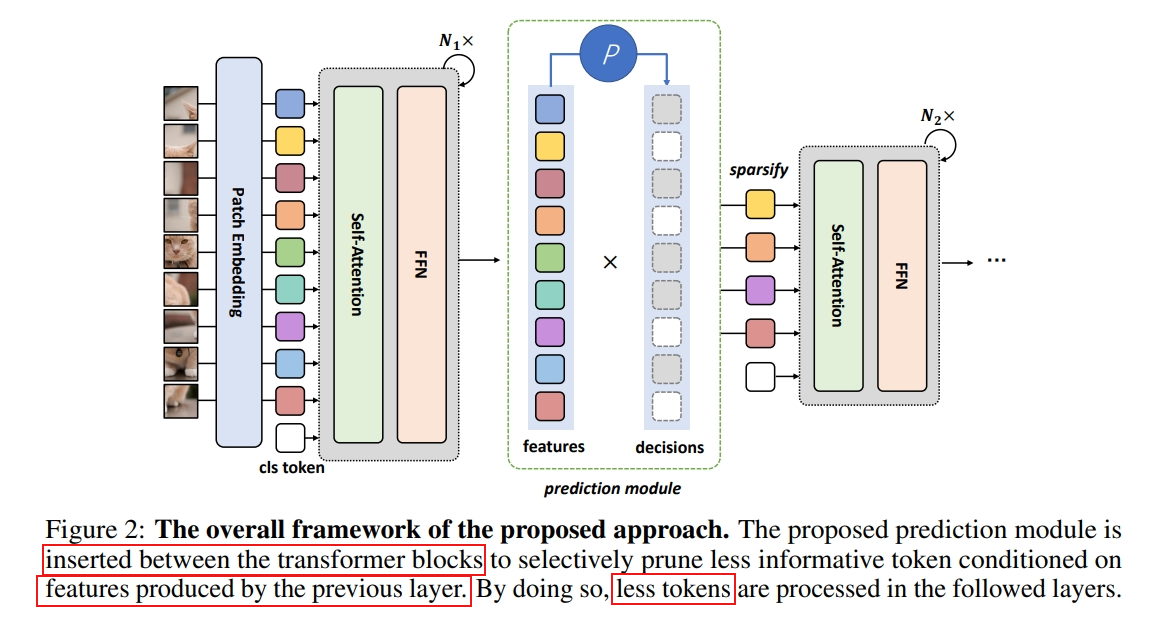DynamicViT: Efficient Vision Transformers with Dynamic Token Sparsification
Abstract
Specifically, we devise a lightweight prediction module to estimate the importance score of each token given the current features. The module is added to different layers to prune redundant tokens hierarchically.
To optimize the prediction module in an end-to-end manner, we propose an attention masking strategy to differentiably prune a token by blocking its interactions with other tokens.
Introduction
Considering the number of zero elements in the binary decision mask is different for each instance, directly eliminating the uninformative tokens for each input instance during training will make parallel computing impossible.
Moreover, this would also hinder the back-propagation for the prediction module, which needs to calculate the probability distribution of whether to keep the token even if it is finally eliminated.
Besides, directly setting the abandoned tokens as zero vectors is also not a wise idea since zero vectors will still affect the calculation of the attention matrix. Therefore, we propose a strategy called attention masking where we drop the connection from abandoned tokens to all other tokens in the attention matrix based on the binary decision mask.
Dynamic Vision Transformers
Overview

Hierarchical Token Sparsification with Prediction Modules
We initialize all elements in the decision mask to 1 and update the mask progressively. The prediction modules take the current decision Dˆ and the tokens x ∈ R ^N×C as input. We first project the tokens using an MLP:
where C' can be a smaller dimension, and we use C' = C/2 in our implementation. Similarly, we can compute a global feature by:
where Agg is the function which aggregates the information all the existing tokens and can be simply implemented as an average pooling:
where π_i,0 denotes the probability of dropping the i-th token and π_i,1 is the probability of keeping it.
We can then generate current decision D by sampling from π and update Dˆ by
indicating that once a token is dropped, it will never be used.
End-to-end Optimization with Attention Masking
First, the sampling from π to get binary decision mask D is non-differentiable, which impedes the end-to-end training.
To overcome this, we apply the Gumbel-Softmax technique to sample from the probabilities π
The output of Gumbel-Softmax is a one-hot tensor.
To achieve parallelized computation, we must keep the number of tokens unchanged to avoid simple yet unstructured pruning.
The zeroed tokens will still influence other tokens through the Softmax operation. To this end, we devise a strategy called attention masking which can totally eliminate the effects of the dropped tokens. Specifically, we compute the attention matrix by:
Training and Inference
To minimize the influence on performance caused by our token sparsification, we use the original backbone network as a teacher model and hope the behavior of our DynamicViT as close to the teacher model as possible.
First, we make the finally remaining tokens of the DynamicViT close to the ones of the teacher model, which can be viewed as a kind of self-distillation:
where t_i and t'_i denote the i-th token after the last block of the DynamicViT and the teacher model, respectively. Dˆ b,s is the decision mask for the b-th sample at the s-th sparsification stage.
Second, we minimize the difference of the predictions between our DynamicViT and its teacher via the KL divergence.
Given a set of target ratios for S stages ρ = [ρ (1), . . . , ρ(S) ], we utilize an MSE loss to supervise the prediction module:
Then we combine the losses mentioned above:
During inference, given the target ratio ρ, we can directly discard the less informative tokens via the probabilities produced by the prediction modules such that only exact ms = ρs N tokens are kept at the s-th stage. Formally, for the s-th stage, let